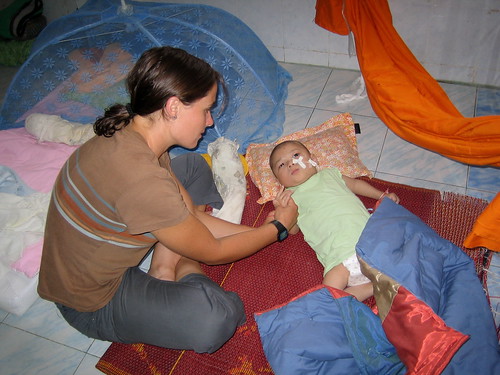Physical Therapy Student
Home: Seattle, WA
On my first morning at the Mae Tao Clinic, I was greeted by what I know as the scent of northern Thailand: an odor that combines fish paste, mildew, sweat, and betel nut. Just past the clinic entrance, a crowd of people, each with a small bag of clothing, sat or stood in the courtyard hoping to receive medical attention, food, and temporary shelter. I soon learned that some of these people had traveled for days or weeks from inside Burma or from refugee camps on the border, often in danger of being caught and detained by border officials. As Lobke, the physical therapist who volunteers there, led me past the crowd and through layers of sandals scattered at the entrance of each small open-aired concrete building, she described the work in store for us in the inpatient, surgical, pediatric, outpatient, and prosthetics departments.
Over the next six weeks�from October to mid-November 2007� Lobke provided me with instruction and demonstrations on stump care and rehabilitation for patients with amputations, passive mobilization, and functional exercises. We then worked together to evaluate and treat patients. Taking into account patients� circumstances and offering the therapy and advice that best met their needs was especially challenging because most of the patients came from precarious living situations, where they were dealing with extreme poverty; lack of food, water, and healthcare; and forced labor or relocation. Many patients also faced landmine hazards and other atrocities under the Burmese military�s ruthless control. By paying close attention to the patients� behaviors and by being deliberate with my facial expressions and voice tones, I strived to offer patients some physical relief, encouragement, and a sense of being cared for.
What they gave back to me was immeasurable. For example, providing therapy to a woman who had fallen unconscious after a seizure and then exhibited neurological dysfunction was challenging, but also very satisfying. When we began treatment, the patient lay quite motionless, showing little awareness of her surroundings. Gradually, she improved and, after ten days of therapy and rest, she smiled, made eye contact, and walked with my support. Observing her progress and watching her confidence return reinforced my belief in physical therapy and my aspiration to join the profession.
My time volunteering at the Thai-Burma border strengthened my heart and mind, pushing me to grow and learn both as a person and as a physical therapy student. Experiencing the challenges first-hand of connecting with each patient and sorting out the most fitting treatment has deepened my understanding of what it means to be a physical therapist and has further prepared me for my future career. I hope to continue to volunteer with Clear Path, and I look forward to returning as a physical therapist to contribute to and learn from the Mae Tao Clinic.

No comments:
Post a Comment